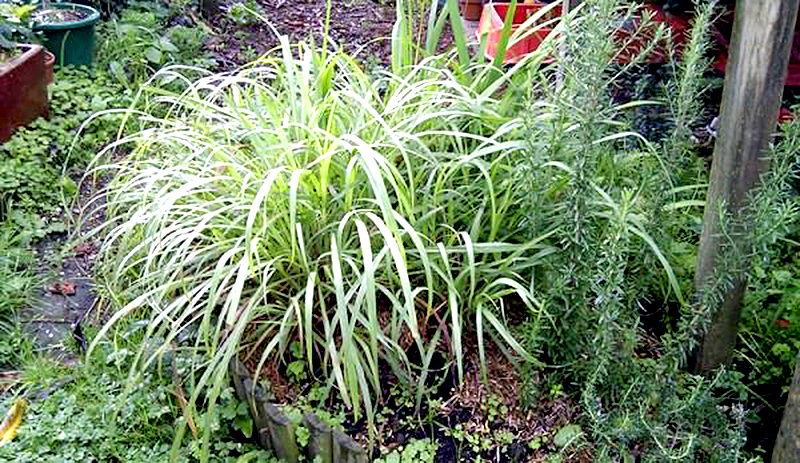
Lemongrass is a versatile herb, prized in the kitchen and known for its medicinal properties. This plant gets its name and unique flavor from citral, the same chemical compound that gives lemon peels their invigorating scent. Sometimes mistakenly called citronella grass, Cymbopogon citratuslends its flavor to ethnic dishes, teas and more.
The Master Gardener Program at the University of Wisconsin Cooperative Extension says that of the 55 species in the genus Cymbopogon, West Indian lemongrass (C. citratus) is what’s typically used for cooking. This variety can help repel insects, yet is also used to attract honey bees by mimicking the bees’ own pheromones. Other known uses for lemongrass include:
- antifungal
- natural diuretic
- anti-parasitical
- anti-diarrheal
- anti-microbial
- anti-bacterial
- calm the stomach
- break down fats
- stimulate perspiration
- treats colds
- balance the nervous system
- help with stress and exhaustion,
- soothe headaches and muscle pain
- increase circulation
- help with respiratory conditions, sore throats and high cholesterol

Grow Lemongrass
Lemongrass performs as a perennial in USDA zones 8 and warmer, loves full sun, and can handle intense heat as long as you don’t let its roots dry out. If given well-drained, rich soil, one clump of lemongrass can easily grow into a mound 3-plus feet tall and 6 feet wide, so choose your location well. I planted my 4-inch pot in a spot up by our pool, thinking it would look tropical and lend fragrance to sunbathing. It did, but by the end of summer, that little plant dominated the whole end of the garden bed!
Overwinter lemongrass in zones 1 to 7 by digging a clump of roots, trimming stalks to a few inches tall, and planting in pots. Lemongrass will fill the container you put it in, and root expansion can break a pot that’s too small pot, so start with one at least 12 inches diameter. Set the pot in a sunny spot indoors and keep barely moist, or store in a cool, dark place, watering just enough to keep the roots alive. Once night-time temperatures reach 40 degrees or above, transplant outdoors. Pests are virtually nil, though spider mites might invade when lemongrass is overwintered indoors.
Propagation is easy—if the lemongrass you buy from your grocery produce section contains the entire base, take a few sections before you’ve peeled them, place in a glass of water, and set it in a sunny location.Before too long, you’ll see little roots begin to sprout. When they’ve reached an inch or more in length, transplant into a pot or the sunny garden spot, water regularly and enjoy.
Use Lemongrass
The first time I cooked with lemongrass, I neglected to research exactly what part to harvest. I just grabbed my kitchen shears, chopped off a nice handful of the arching leaves, washed them, cut to 1-inch lengths and threw them in my Tom Kha Gai soup. The flavor was incredible. However, the grass didn’t wilt into nice little edible shoots as I expected: It was tougher than celery strings and sharp on the edges.
Since then, I’ve learned that while the stems and leaves are great for infusing flavor into teas and broths, you’ll want to bundle them together so you can take them out later. It is the scallion-like base you’re after if you’re going to be eating lemongrass. When stem bases are at least 1/2 inch thick, you can pull or cut them off the main clump. Peel the outer layer to reveal the white inside part. Slicing is easier if you crush the base with the flat of your knife.
This inner stalk lends an Asian flavor to your stir-fry, and pizazz to salads and sauces, as well. Freeze leftovers in zipper-sealed bags, pre-sliced, or slice when partially thawed. Alternately, purée and use by the teaspoonful, freezing leftovers.
If you’re unable to use all the fresh leaves during the growing season, harvest a bunch to bundle, hang to dry, then store in tightly sealed containers. Dried lemongrass will remain potent for up to a year if not exposed to light. The dried leaves are great many of the same purposes you’d use the fresh leaves. Alternately, scatter grass stems around your patio, porch or pool to help ward off insects. Other uses for lemongrass include but are not limited to:
- adding interest and fragrance in flower arrangements
- new starts in pretty pots make fun housewarming gifts
- tinctures and balms for topical use
- inclusion in potpourri mixture or favorite teas
- feed for chickens
- compost
All in all, whether you eat it, drink it, apply it, smell it, or more, you’ll be hard put to find a plant as versatile and tasty. Maybe there’s a corner of your yard or garden waiting to host its own burst of lemongrass!
Get more growing tips from HobbyFarms.com:





One reply on “How to Grow and Use Lemongrass”
[…] and easy to care for, lemongrass can be a delightful addition to your kitchen garden or home landscape. Here’s what you need to […]